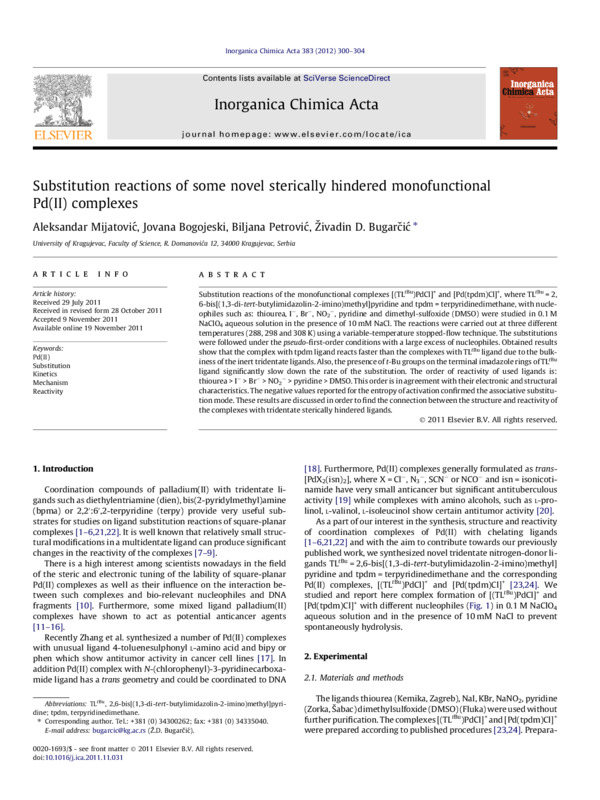Substitution reactions of some novel sterically hindered monofunctional Pd(II) complexes
Објеката
- Тип
- Рад у часопису
- Верзија рада
- објављена верзија
- Језик
- енглески
- Креатор
- Aleksandar Mijatović, Jovana Bogojeski, Biljana Petrović, Živadin D. Bugarčić
- Извор
- Inorganica Chimica Acta
- Издавач
- Elsevier BV
- Датум издавања
- 2011
- Сажетак
- Reakcije supstitucije monofunkcionalnih kompleksa [(TLtBu)PdCl]+ i [Pd(tpdm)Cl]+, gde je TLtBu = 2,6-bis[(1,3-di-terc-butilimidazolin-2-imino)metil]piridin i tpdm = terpiridindimetan, sa nukleofilima kao što su: tiourea, I−, Br−, NO2−, piridin i dimetil-sulfoksid (DMSO) proučavani su u 0,1 M vodenom rastvoru NaClO4 u prisustvu 10 mM NaCl. Reakcije su sprovedene na tri različite temperature (288, 298 i 308 K) korišćenjem tehnike zaustavljenog protoka na različitim temperaturama. Reakcije supstitucije su praćene pod uslovima pseudo prvog reda sa velikim viškom nukleofila. Dobijeni rezultati pokazuju da kompleks sa tpdm ligandom reaguje brže od kompleksa sa TLtBu ligandom zbog voluminoznosti inertnih tridentatnih liganda. Takođe, prisustvo t-Bu grupa na terminalnim imadazolnim prstenovima TLtBu liganda značajno usporava brzinu supstitucije. Redosled reaktivnosti korišćenih liganada je: tiourea > I− > Br− > NO2− > piridin > DMSO. Ovaj redosled je u skladu sa njihovim elektronskim i strukturnim karakteristikama. Negativne vrednosti prijavljene za entropiju aktivacije potvrdile su asocijativni mehanizam supstitucije. Ovi rezultati su razmatrani u cilju pronalaženja veze između strukture i reaktivnosti kompleksa sa tridentatnim voluminoznim ligandima.
- Substitution reactions of the monofunctional complexes [(TLtBu)PdCl]+ and [Pd(tpdm)Cl]+, where TLtBu = 2,6-bis[(1,3-di-tert-butylimidazolin-2-imino)methyl]pyridine and tpdm = terpyridinedimethane, with nucleophiles such as: thiourea, I−, Br−, NO2−, pyridine and dimethyl-sulfoxide (DMSO) were studied in 0.1 M NaClO4 aqueous solution in the presence of 10 mM NaCl. The reactions were carried out at three different temperatures (288, 298 and 308 K) using a variable-temperature stopped-flow technique. The substitutions were followed under the pseudo-first-order conditions with a large excess of nucleophiles. Obtained results show that the complex with tpdm ligand reacts faster than the complexes with TLtBu ligand due to the bulkiness of the inert tridentate ligands. Also, the presence of t-Bu groups on the terminal imadazole rings of TLtBu ligand significantly slow down the rate of the substitution. The order of reactivity of used ligands is: thiourea > I− > Br− > NO2− > pyridine > DMSO. This order is in agreement with their electronic and structural characteristics. The negative values reported for the entropy of activation confirmed the associative substitution mode. These results are discussed in order to find the connection between the structure and reactivity of the complexes with tridentate sterically hindered ligands.
- том
- 383
- Број
- -
- почетак странице
- 300
- крај странице
- 304
- doi
- 10.1016/j.ica.2011.11.031
- issn
- 0020-1693
- Subject
- Materials Chemistry, Inorganic Chemistry, Physical and Theoretical Chemistry
- Шира категорија рада
- M20
- Ужа категорија рада
- М22
- Права
- Отворени приступ
- Лиценца
- Creative Commons – Attribution-NonComercial-No Derivative Works 4.0 International
- Формат
Aleksandar Mijatović, Jovana Bogojeski, Biljana Petrović, Živadin D. Bugarčić. "Substitution reactions of some novel sterically hindered monofunctional Pd(II) complexes" in Inorganica Chimica Acta, Elsevier BV (2011). https://doi.org/10.1016/j.ica.2011.11.031 М22
This item was submitted on 9. децембар 2021. by [anonymous user] using the form “Рад у часопису” on the site “Радови”: http://romeka.rgf.rs/s/repo
Click here to view the collected data.
